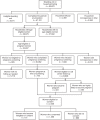Recruitment of women in the National Children's Study Initial Vanguard Study
- PMID: 24793429
- PMCID: PMC4036215
- DOI: 10.1093/aje/kwu062
Recruitment of women in the National Children's Study Initial Vanguard Study
Abstract
The initial Vanguard Study of the National Children's Study was conducted during 2009-2010 in 7 locations in the United States. A goal was to evaluate the feasibility and yield of a household-based sampling design to recruit pregnant women. A multistage area probability sampling design was used to identify study locations (generally, counties) that were subsequently divided into smaller geographical units, termed segments. Between 7 and 18 segments were selected in each location, and dwelling units within segments were listed. A household-based recruitment process was implemented, which included enumeration of households to identify age-eligible women, pregnancy screening to identify pregnant women eligible for immediate enrollment and nonpregnant women for telephone follow-up, and administration of informed consent to eligible women. After a recruitment period of 17-20 months, 67,181 (89%) households were enumerated, which identified 34,172 (88%) age-eligible women to whom the pregnancy screener was administered. Among those who completed the screener, 2,285 women became eligible for enrollment, of whom 1,399 (61%) enrolled. Although response rates were fairly high at initial contact and among pregnant women, the overall yield was lower than anticipated. In particular, telephone follow-up of nonpregnant women was not a practicable strategy for prospective recruitment of newly pregnant women.
Keywords: National Children's Study; birth cohort; children; epidemiology; population; recruitment; sampling.
© The Author 2014. Published by Oxford University Press on behalf of the Johns Hopkins Bloomberg School of Public Health. All rights reserved. For permissions, please e-mail: journals.permissions@oup.com.
Figures
Similar articles
-
The National Children's Study: Early Recruitment Outcomes Using the Direct Outreach Approach.Pediatrics. 2016 Jun;137 Suppl 4(Suppl 4):S231-8. doi: 10.1542/peds.2015-4410D. Pediatrics. 2016. PMID: 27251869 Free PMC article.
-
Comparison of Recruitment Strategy Outcomes in the National Children's Study.Pediatrics. 2017 Aug;140(2):e20162822. doi: 10.1542/peds.2016-2822. Pediatrics. 2017. PMID: 28724571 Free PMC article.
-
Multilevel Provider-Based Sampling for Recruitment of Pregnant Women and Mother-Newborn Dyads.Pediatrics. 2016 Jun;137 Suppl 4(Suppl 4):S248-57. doi: 10.1542/peds.2015-4410F. Pediatrics. 2016. PMID: 27251871 Free PMC article.
-
Folic acid supplementation and malaria susceptibility and severity among people taking antifolate antimalarial drugs in endemic areas.Cochrane Database Syst Rev. 2022 Feb 1;2(2022):CD014217. doi: 10.1002/14651858.CD014217. Cochrane Database Syst Rev. 2022. PMID: 36321557 Free PMC article.
-
A Proposed Hybrid Sampling Frame for the National Survey on Drug Use and Health: Final Report [Internet].Rockville (MD): Substance Abuse and Mental Health Services Administration (US); 2012 Mar. Rockville (MD): Substance Abuse and Mental Health Services Administration (US); 2012 Mar. PMID: 30299638 Free Books & Documents. Review.
Cited by
-
The National Children's Study: An Introduction and Historical Overview.Pediatrics. 2016 Jun;137 Suppl 4(Suppl 4):S213-8. doi: 10.1542/peds.2015-4410B. Pediatrics. 2016. PMID: 27251867 Free PMC article.
-
Recruitment and retention of pregnant women in prospective birth cohort studies: A scoping review and content analysis of the literature.Neurotoxicol Teratol. 2021 May-Jun;85:106974. doi: 10.1016/j.ntt.2021.106974. Epub 2021 Mar 22. Neurotoxicol Teratol. 2021. PMID: 33766723 Free PMC article.
-
Placental gross shape differences in a high autism risk cohort and the general population.PLoS One. 2018 Aug 22;13(8):e0191276. doi: 10.1371/journal.pone.0191276. eCollection 2018. PLoS One. 2018. PMID: 30133439 Free PMC article.
-
Lessons from Prenatal Care Provider-Based Recruitment into the National Children's Study.Pediatr Rep. 2015 Sep 28;7(3):6056. doi: 10.4081/pr.2015.6056. eCollection 2015 Sep 28. Pediatr Rep. 2015. PMID: 26500750 Free PMC article.
-
Effectiveness of community outreach and engagement in recruitment success for a prebirth cohort.J Clin Transl Sci. 2017 Jun;1(3):184-191. doi: 10.1017/cts.2017.7. Epub 2017 Jul 19. J Clin Transl Sci. 2017. PMID: 29082032 Free PMC article.
References
-
- Landrigan PJ, Trasande L, Thorpe LE, et al. The National Children's Study: a 21-year prospective study of 100,000 American children. Pediatrics. 2006;118(5):2173–2186. - PubMed
-
- National Research Council and Institute of Medicine. The National Children's Study Research Plan: A Review. Washington, DC: National Academies Press; 2008.
Publication types
MeSH terms
Grants and funding
LinkOut - more resources
Full Text Sources
Other Literature Sources


